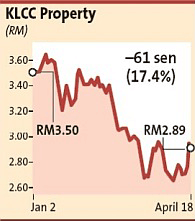
An artist’s impression of the Asia Pacific Trade and Exhibition City
The Cityscape Asia 2008 held at the Suntec City convention centre in Singapore saw the “big boys” in Johor making their presence felt at the international property investment and development exhibition from April 15 to 17.
They included the 1,840-acre Danga Bay integrated waterfront project, Mulpha's 1,765-acre Leisure Farm Resort, Bandar Raya Developments Bhd's 1,400-acre Permas Jaya, Country View Group's 1,100-acre Taman Universiti and UEM Land's Bandar Nusajaya, the key driver of Iskandar Malaysia.
SP Setia, with several successful projects in Johor, was also there to exhibit among others, its latest project, the Setia EcoCity, the premier commercial and business hub in Bandar Nusajaya, the gateway into Iskandar Malaysia.
They all took up large booths.
However, a new development that stole the show was Malaysia Pacific Corp Bhd's (MPC) Lakehill Resort City near Pasir Gudang in Iskandar Malaysia.
Many curious visitors, including foreigners, were seen crowding around the large model of Lakehill Resort City.
MPC staff had their hands full briefing the visitors on this 484-acre resort township, which is part of MPC's 905-acre freehold Nusa Damai, at the eastern zone of Iskandar Malaysia – a 2,217 sq km special economic zone covering the logistic triangle of Senai Airport (north), Tanjung Pelepas Port (south west) and Johor Port in Pasir Gudang (south east).
Developed by Lakehill Resort Development Sdn Bhd, an MPC subsidiary, it will take about eight years to complete and will have a gross development value of about RM6bil.
What sets this project apart from the rest is that instead of merely selling houses, MPC is trying to make Lakehill Resort City a trading, distribution, entertainment, shopping and tourism hub that would bring in lots of investors to Iskandar Malaysia and boost trade and economic activities for Johor and the country.
The centrepiece is the Asia Pacific Trade & Expo City (APTEC) where MPC will help manage, among other things, the sourcing and distribution of goods from around the region, particularly from China, India and Asean countries.
Critics may view it as putting too many “goodies” on a single plate, but MPC chief executive officer Bill Ch'ng, with his vast experience as a “turnaround wizard”, political and business contacts in China and Hong Kong, is confident that his vision of creating another “Shenzhen-Hong Kong” economic miracle in Malaysia would be a reality.
Ch'ng is a visionary and he is going to bring much excitement to the Johor property market with his innovative concepts and designs. For example, he is creating a kind of timeshared living by having a four-villa cluster sharing a swimming pool in the centre. It would be ideal for extended/large families, each owning a villa or for company use.

The man-made beach at the proposed RM6bil Lakehill Resort City
Besides APTEC, the resort township will also have the following components:
Heritage and Cultural Village: It will be a one-stop tourism hub, where 13 pavilions will exhibit the unique arts, crafts and various types of cuisines offered in each state in Malaysia. There will be alfresco international dining along the waterfront restaurants, bistros and cafes. Diners will be treated to weekly musical fountain shows at the Emerald Lake. A special attraction will be 13 traditionally handcrafted Malaysian-styled gondolas, each representing the 13 states' cultures.
Lakehill Regency Lake: This enclave will have the 6-star Lakehill All-Suites Resort & Convention Hotel, Lakehill Medical & Healthcare Specialist Centre, Lakehill Platinum Residences, Lakehill Power Resort Club and Lakehill Golf Village.
The resort club's membership will be open to buyers of Lakehill Resort City homes and by invitation only. It will have a fine dining club with a large spa and rejuvenation centre.
The Platinum Residences will be a luxury retirement home with 24-hour room service and nursing care upon request and will be manned by a team of doctors and nurses.
There will be some putting greens and driving range for private practice. It will complement the existing 54-hole Tanjung Puteri Golf Course and the 18-hole Octville Golf & Country Club, just 20 minutes away.
Nusa Paradis: This will be the lifestyle entertainment centre showcasing international restaurants, amusement park, dance clubs, karaoke and quaint shopping outlets. It is designed to be a vehicle free zone and hand-drawn rickshaws and trishaw rides will be offered to visitors. The theme is comparable to Universal Studios.
Factory Outlet: Visitors can view thematic buildings in this “cowboy town” and drop in at the sheriff's office and enjoy stagecoach rides. It will be a shoppers' “paradise” as branded goods will be sold at discounted price. Off-season fashion products and electronics goods from APTEC will also be sold here.
Real Rock Cafe: This is another “happening place” where the young as well as young at heart can meet over a cup of cappuccino while enjoying the view below from a five-storey, three-acre rock formation. Visitors can take a bubble lift or climb a rocky pathway passing by a man-made waterfall.
Lakehill Commercial Training Centre: It will be the first of its kind in Malaysia where specialised courses in tourism, hotel management, food and beverage services, business management, retail, health and beauty therapy and other vocational training will be conducted and serve as a source for special skilled workforce for the Lakehill Resort City's staffing needs.
By The Star (by S.C.Cheah)













